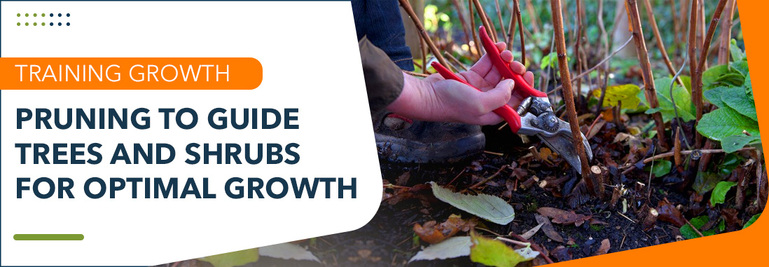What is Pruning?
Important Facts to Know About the Process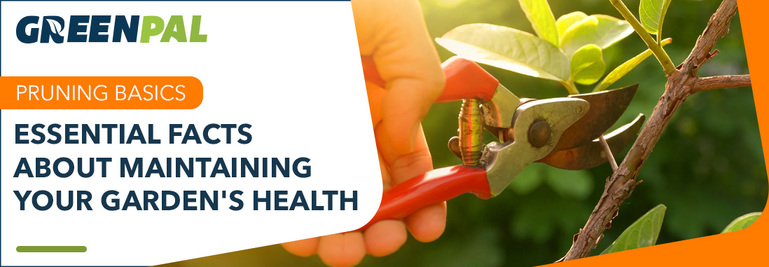
Pruning. Thought about it lately? Probably not. For many, pruning is something they loath to do. It's often daunting. In this guide, we'll not only answer the question, "What is pruning?" but we'll share why pruning is important and compare it with other tasks such as shearing.
What is pruning?
Pruning is an essential process to keep trees, shrubs, and perennials healthy, intact, and attractive.
Merriam-Webster defines pruning as "to cut off or cut back parts of for better shape or more fruitful growth."
Infographic: The Importance of Pruning Trees
There are several reasons to prune:
Restrict growth
Maintain plant health
Improve the quality of fruit, flowers, stems, and foliage
Guide plant growth
Pruning is also great for maintaining the weight and look of plants. It helps keep plants healthy by keeping back overgrowth and allowing air and light to distribute through plants and trees.
Why is pruning important?
Pruning has a significant impact on plant health. How do you help prevent plant disease? Prune. Dead stems open the door to disease and pests.
The pruning process also allows plants and trees to be given shape and helps in fruit production, especially for those with heavier fruits, like apple and pear trees, where pruning helps the tree better situate the fruit and manage the added weight.
Like mentioned before, pruning is used to control growth and plant size and get rid of dead or diseased plant parts. Pruning can also help fight and eliminate pests if done correctly.
Ultimately, the process encourages new growth, aids in air circulation, flowering, and fruiting, and helps keep a garden landscape tidy and well-maintained.
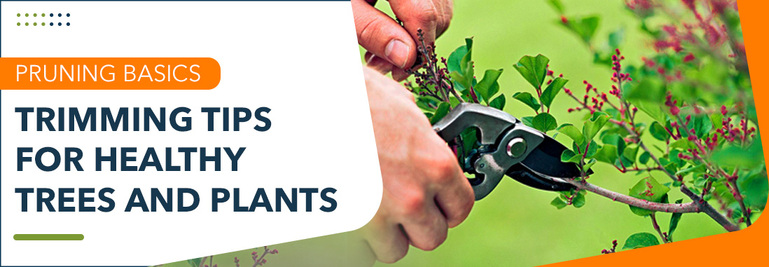
How to Prune Trees and Plants
Pruning takes discipline and a knowledge of a plant’s growth pattern and needs. First, identify which branches must be pruned:
Dead or damaged branches
Shoots that cross over one another
Sagging branches
Cut with clean, sharp tools regardless of what you're using. Diseases can transfer between plants. Use a bleach and water mix to clean between cuts on different plants. Dry thoroughly.
Welsh and Janne note that in "most cases, it is better not to prune than to do it incorrectly. In nature, plants go years with little or no pruning, but man can ruin what nature has created. By using improper pruning methods healthy plants are often weakened or deformed. In nature, every plant eventually is pruned in some manner."
Pruning isn't as simple as grabbing a pruning saw or a chainsaw and going out to work. It takes proper planning and know-how. Pruning aims to remove the parts of a plant or tree that are not beneficial to growth. It's all about identification and clean cuts. Any more and the plant may be harmed.
How to Create a Pruning Plan
To correctly prune, a plan is a necessity. Why? It reduces the number of unnecessary cuts and helps reduce errors. Here are a few tips to plan well:
Identify the parts of the plant that need pruning
Many limbs are problem limbs. They unnecessarily entangle others and cover the canopy, limiting the amount of sun and rain reaching the ground floor.
Dead, broken, and diseased branches must also be cut back to a healthy lateral shoot or branch. Identifying and removing these types of branches is all that is needed in most cases.
Guide the plant on where and how to grow
The next step in a pruning plan is to think through cuts that will train the tree or shrub. A plant will always favor its natural growing path but can be trained. This process of pruning is often used by professional landscapers and best avoided without proper training.
When cutting, keep the growth pattern of the tree or plant intact as much as possible. Each plant has a natural course it wants to take. Understanding a tree or shrub's natural growth pattern is vital. The plant or shrub may accept the training and redirect its growth by making minor cuts at the lateral branch level.
Don't do too much at once and only use such methods to achieve the desired aesthetic or fill in an area.
Read More: Why Hire a Landscaper?
Homeowners can also hire a professional if they're unsure about best pruning practices. Pruning aims to keep trees, shrubs, and plants healthy. Unfortunately, improper pruning harms many otherwise healthy plants. A professional can prune decoratively while still maintaining a plant's health.
Finding the right tool for the job is an essential part of pruning
Selecting the right tools remains an essential part of pruning. Different tools help homeowners prune in various situations. Pruning shears, loppers, pruning saws, and hedge trimmers each meet a specific need.
Pruning shears are generally used to make cuts on smaller branches. Loppers make thicker cuts easier and give users a more powerful pruning tool.
Pruning saws take it to the next level and help homeowners tackle branches that are larger in diameter.
For pruning tall trees with medium or small-diameter branches, pole pruners (also called telescopic pruners) mitigate the risk of accidents caused by reaching up to prune a branch by extending your arm to reach up from the ground and into the canopy.
Keep your tools sharp. Clean blades slice through branches. Dull blades can cause further harm to a plant's or tree's internal systems, leaving them susceptible to harmful pests and fungi.
When to Prune (And When Not to)
Different plants do better on different pruning schedules. But pruning is about awareness more than it is finding the perfect time to prune. Here are a few things to keep in mind:
Avoid pruning in extremely hot temperatures. Heat stresses plants and pruning is one more challenge for it to deal with.
Don’t prune when sap is flowing. Make a small cut first to see if the sap is present and put off a complete prune until it’s done.
Hold off on pruning during extreme cold. While late winter can be a good time to prune most plants, extreme cold increases the risks of brittle branches unintentionally snapping off and leaving the plant vulnerable.
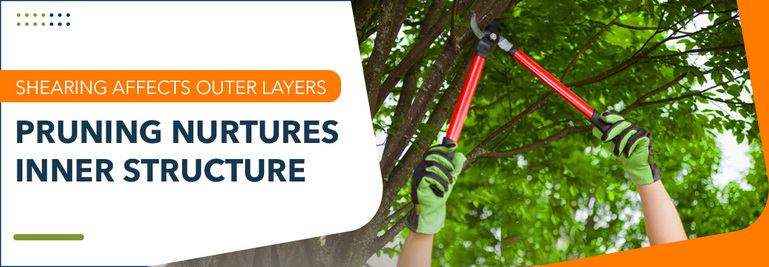
What is the difference between shearing and pruning?
Pruning is a selective process to keep plants, shrubs, and trees healthy. Shearing is about growth maintenance on outer layers. Shearing is often used to create a particular aesthetic. (To be fair, so is pruning sometimes, but the real goal of pruning is plant health).
Ultimately, shearing is not a planned process to maintain a plant's well being. Pruning is.
Quick Summary
Key Aspects |
Details |
Definition |
Pruning involves cutting back parts of plants for better growth, health, and aesthetics. |
Importance |
Pruning is crucial for plant health, disease prevention, improved fruit/flower quality, and growth control. |
How to Prune |
Identify and remove dead/damaged branches, maintain clean tools, follow plant growth patterns, and avoid over-pruning. |
Creating a Pruning Plan |
Identify problem limbs, guide plant growth, and avoid overdoing it by planning cuts based on plant's natural pattern. |
Choosing Tools and Timing |
Use appropriate tools (shears, loppers, saws) and prune at suitable times (avoid extreme heat/cold and sap-flowing). |
Pruning is necessary to keep trees, shrubs, and flowers healthy. When it comes to pruning your plants, choosing the right tools and keeping them sharp and clean is essential. The best time to prune depends on the plant's bloom season, and a homeowner must have a plan for pruning.
Pruning is about maintaining a plant's health, while shearing is generally for curb appeal.
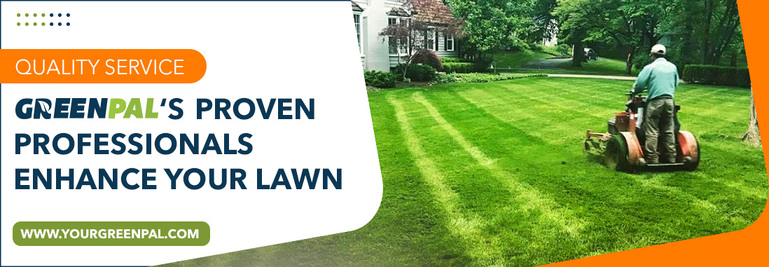





 Share
Share




